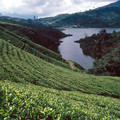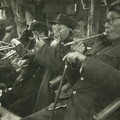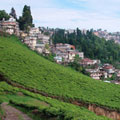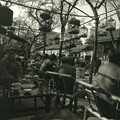Quotes - Tea production
„There is also a lack of formal definition for "gu shu." Some say "gu shu" should only refer to trees over 300 years of age, that is left to grow tall, and not pruned back. But in reality, most "gu shu" trees are cultivated, which entails annual pruning to encourage regrowth & lower branches for easy picking. A lot of "gu shu" on the market comes from trees as young as 100 years old, some of which is as short as 1.5m high. But a 100 year old tea tree growing in the wild can also grow higher than 3m high. Eventually the government will legislate what classifies as "gu shu." Until then, let the buyer beware!“
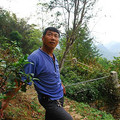
Quotes Tags: Pu-erh, Gushu, Tea production
„The terms "Xiao shu" (small tree) and "tai di" (terrace plantation) are often interchangeably used, but they should be given separate meanings. "Tai di" connotes high intensity farming, with the entire slope cleared & terraced to plant hedgerows & use of pesticide & fertilizer. But in many gu shu growing villages, there are also new tea plantations which are too young to be called gu shu (ie. less than 100 years old), but they aren't exactly "tai di" either. Many of these plants are growing next to old trees, in a bio-diverse forest clearing, with lots of space around them, not all are sprayed & fertilized. In the future, they will grow into "gu shu", until then we should call them "shen tai xiao shu" (naturally grown small trees)“
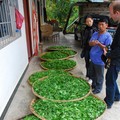
Quotes Tags: Pu-erh, Gushu, Tea production
„I had heard from other puer buyers that Ma Hei farmers now use pesticide & fertilizer to boost yields. But as we stood there critiquing this batch of Ma Hei tea, a large, multi coloured beetle crawled out of the leaf pile. “We call this guy the tea boss” Mr. Gao explained. “If he’s around, it’s a good sign!”“
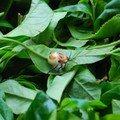
Quotes Tags: Pu-erh, Gushu, Tea production
„When examining maocha, the colour of gu shu leaves tend to be more highly contrasted with a bright white hairy bud/tip surrounded by a grey, open leaf wrapper, with dark black stem & leaves. By comparison, tai di cha is almost all black, due to the use of fertilizer, the leaves grow quickly and the buds have less white hairs.“

Quotes Tags: Pu-erh, Gushu, Tea production
„Mr. Gao showed us how to identify gu shu (ancient tree) tea leaves by looking at their texture, rubbing them between your fingers, and eating them raw. Old tea trees produce thicker, more leathery leaves that don’t easily come apart when you rub them. And gu shu buds should be white & shiny. When you chew them, the flavor is very bitter but there is also a strong sweet fragrance, and the juice is relatively easy to swallow. Tai di cha (terrace plantation tea) is also bitter but with a strong, lasting astringency on the sides & front of the tongue, and the juice is harder to swallow.“

Quotes Tags: Pu-erh, Gushu, Tea production, Experiencing tea
„Mr. Gao pointed out some caterpillars that were fattening themselves on tea leaves. “No pesticides used here.”“
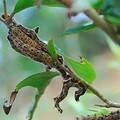
Quotes Tags: Pu-erh, Gushu, Tea production
„At the beginning of 1990s, many small tea factories were born. Some of them started to use class level 3 (or even higher) raw tea (which was only available for emperors in the past) instead of level 6 (or even lower) raw tea (which was the traditional material for producing Pu Erh Tea).“
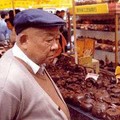
Quotes Tags: Pu-erh, Tea production, China
„Meng-Hai Tea Factory started to use the trademark "Da-Yi" around 1978. Xia-Guan Tea Factory started to register the trademarks "Song-He" and "Nan-Zhao" in 1992.“

Quotes Tags: Pu-erh, Tea production, China
„Black Puerh Tea was invented by Kunming Tea Factory in 1972/73 and was manufactured in Xia-Guan Tea Factory ever since 1976. It is now manufactured in many different factories and is by far the most popular type of puerh sold.“

Quotes Tags: Pu-erh, Shu - Ripe Puerh, Tea production, China
„Standard Tuocha tea were defined to weigh 100 gram each. Five make 1 Tong.“

Quotes Tags: Pu-erh, Tuocha, Tea production, China
„Brick Tea was mainly produced in the Si-Chuang province prior to 1949. It is now also available in other provinces as well.“

Quotes Tags: Pu-erh, Brick, Tea production, China
„In 1940, the Chinese State owned company CNNP started to manufacture Pu Erh Tea with a trademark "Zhong-Cha" at the Fo-Hai Tea Factory (now called "Meng-Hai Tea Factory"). Later, Yun-Nan Tea Company and Guang-Dong Tea Company also produced the same brand and started to export abroad. There were varieties such as red-label, green-label, yellow-label, small-letter and big-letter etc.“

Quotes Tags: Pu-erh, Tea production, China
„Mushroom shaped tea appeared in 1912. It was invented at that time in order to prevent the tea from going mouldy during the transportation. It was produced in Xia-Guan and Fo-Hai (two cities in south China) with the trademark "Bao-Yan". The production was then stopped in 1966. In 1986, the production was resumed due to the request of Buddhists in Tibet.“

Quotes Tags: Pu-erh, Mushroom - Jin Cha, Tea production, China
„Head Tea (aka Golden Melon) is shaped like a ball, weighing between 2 Liangs and 10 Jins ( 1 Jin = 500 grams). They were mainly for domestic trade or serving as tributes to emperors. Stacks of Golden Melons progressing in size from gigantic to small are considered to be a status symbol.“

Quotes Tags: Pu-erh, Tea production, China
„The most classical Puerh Tea is the Bingcha, recorded in Yong-Zheng 13th year in Qing Dynasty (1735). Each tea cake weighs 7 Liang (357 grams). Seven cakes make 1 Tong (wrapped in leaves), weighing 49 Liang. It was sold in nice places and also was exported abroad. It was re-named as "Yunnan Qizi bingcha - Yunnan seven cake tea" during the Cutural revolution.“

Quotes Tags: Pu-erh, Cake, Tea production, China
„Yunnan Tea Company standardized the trade number for Pu Erh Tea in 1976 for the purpose of export. Each bingcha has 4 digits: the first 2 digits indicate the manufacturing year, the third digit indicates the leaf grade, the last digit indicates the tea factory (e.g. Kun-Ming 1, Meng-Hai 2, Xia-Guan 3, Pu Erh 4). The loose-leaf tea has 5 digits with the third and fourth indicating the class level of raw materials. Examples of early trade numbers for Puerh Tea are 7452, 7562, 7572, 75671, 76563.“
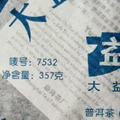
Quotes Tags: Pu-erh, Tea production, Cake, China
„Yu Shui Cha; 雨水茶. Literally Rain water tea. Summer Tea. Less prized than Spring Tea or Autumn Tea. The flavour is usually less fulsome than Spring tea. Also, it is often oven-dried (hong qing; 烘青) as it is harvested in the rainy season.“
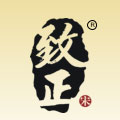
Quotes Tags: Tea production, China, Pu-erh
„wo dui; 渥 - Wet, 堆 heap/pile - Wo dui - 渥堆, Literally wet -pile The process of 'pile fermentation which is used to make 'aged' Puer tea.“

Quotes Tags: Shu - Ripe Puerh, Pu-erh, Tea production, China
„tong feng; 通风 - air-flow. Puer should be stored somewhere where there is a little air movement - it doesn't need to be much. Even if it is quite humid, the airflow will guard against tea developing mould. However, care should be taken that tea is not stored in a draft which will dry the tea tea out.“

Quotes Tags: Pu-erh, Tea production, China
„tong; 筒 - Literally a barrel or barrel shaped object. A tong in Yunnan tea culture is a bundle of 7 tea cakes wrapped in the outer skin of bamboo which naturally sheds from around the base of the bamboo stem. Each cake weighs 357grams so making a total of 2,499 gm. Said by some to have been calculated in order to remain under a specific legislated weight of 2.5 kg. There were originally said to be 8 cakes in a tong. The 8th being paid as a levy. An earlier unit of weight in China was the liang. A cake of tea weighed 7 liang and 7 cakes in a tong made 49 liang. “

Quotes Tags: Pu-erh, Tea production, Yunnan, China
„tan qing; 摊青 - The process of laying freshly picked leaves out to allow the moisture content to diminish before frying“

Quotes Tags: Tea production, China
„shi cang; 湿仓 - wet storage. Storage that is intentionally humid. Done in order to attempt to speed up the ageing process of Puer tea. It has risks associated with it from effectively shortening the 'life' of the tea, having a deliterous effect on the plant constituents - not least the aromatics compounds to ruining the tea altogether.“

Quotes Tags: Pu-erh, Tea production, China, Experiencing tea
„shai qing; 晒青 - Sun dried. This is a critical aspect of Puer Tea processing. Oven dried tea is considered inferior to sun-dried. The Provincial Government has ruled that Puer tea must be sun-dried.“

Quotes Tags: Pu-erh, Tea production, China
„sha qing; 杀青. Literally to kill. So 杀青 translates as killing green. The process of pan 'frying' fresh tea arrests the action of plant enzymes that will have begun after picking.“

Quotes Tags: Tea production, China
„Yunnan Provincial Government has stipulated that for tea to qualify as Pu er it must be:
i) of the Broad Leaf variety (Sinensis Assamica)
ii) grown in the Lancang (Mekong) River region
iii) sun dried. The third point is important as there is much tea grown in the Lancang River area that is not sun dried.
There are also increasing amounts of Small Leaf Variety (Xiao Ye Zhong /小叶种) being grown in the Lancang River area.“

Quotes Tags: Pu-erh, Tea production, Yunnan, China, Lancang
„pin pei; 拼配. A blend or mix. pin pei Puer comes in many forms; tea from a particular place, but comprising of old tea tree leaves mixed with tea bush leaves or, old tree tea from different areas or seasons mixed together, or finally, a combination of all of the above. “

Quotes Tags: Tea production, China
„Pang xie jiao; 旁鞋脚. Latin; (Viscum articulatum Burm.f.) Literally Crabs legs. A parasitic plant that grows on trees in sub-tropical regions. When it grows on the tea tree it absorbs flavour from the tree and makes a sweet, refreshing drink, hot or cool. Very limited availability. Puer cakes can be found that have Pangxiejiao mixed into the cake. Normally around 10-15%. It is also part of the Chinese medicine pharmacopoeia – said to have a diuretic effect and is used to clear heat“

Quotes Tags: Pu-erh, Tea production, China, Health
„mao cha; 毛茶 - Tea that has been dry fried in a tea wok & then rolled & dried.“

Quotes Tags: Tea production, China, Maocha
„ji qi sha (de); 机器杀(的) - Machine fried. Most tea famers have a machine for the sha qing process, which is generally an electrically driven revolving drum, fired by a wood fire. Machine fried tea is probably better than poorly hand fried tea, but lacks the possibility of the more tactile method of hand frying.“

Quotes Tags: Tea production, China
„ji qi rou (de); 机器揉(的) - Machine rolled. Some machine rolled tea has a very pleasing appearance and most tea gardens, however small, will have a machine, which is generally electric, but sometimes hand operated. However, the best sheng puer tea is still hand rolled.“

Quotes Tags: Tea production, China
„hou fajiao; 后发酵 - Post-fermented. 后hou - behind, after. 发; fa - has many meanings; to develop, expand, bring into existences, start; rise or expand when fermented. 酵 jiao - fermented. Together 发酵 means to ferment. Confusion often arises as the term fajiao is used to refer to both processes of fermentation and oxidation. The more specific term yang hua - 氧化 refers specifically to oxidation.“

Quotes Tags: Tea oxidation, Tea production, China
„hun he; 混合 - A mix or blend. Perhaps with some derogatory connotation. Used by some to refer to pin pei cha. i.e tea that is not pure; not tea from one single place, season and/or type of tree. e.g. old tree tea leaves from two or more places , or tea from the same place but not only from old or ancient trees or bushes, or from different seasons. “

Quotes Tags: Tea production, China
„hong qing; 烘青. Oven dried. Oven dried tea is generally felt to be inferior to sun-dried. However, most tea producers have one, often wood fired, oven, which is used to dry leaves if time or weather does not permit sun or air drying. “

Quotes Tags: Tea production, China
„hong; 红 - red. In China, what is called black tea in the English speaking world, is called red. Cooked Puer is sometimes mistakenly referred to as a black tea.“

Quotes Tags: Shu - Ripe Puerh, Red tea, Black tea, Pu-erh, Tea production, China
„guan mu; 灌木 - Literally means bush or shrub. 灌 - guan, to irrigate. This style of cultivation is relatively new in Yunnan, having only started in the early to mid 20th Century. Tea bushes are cultivated in rows. Guan mu cha is the tea from cultivated bushes.“

Quotes Tags: Tea production, Yunnan, China
„fa jiao; 发酵 - To ferment/fermented. Shu Puer tea is a made by a process of fermentation. Raw puer is referred to as hou fa jiao cha - post-fermented tea -which technically is said to be a mix of oxidation and fermentation.“

Quotes Tags: Sheng - Raw Puerh, Pu-erh, Tea production, China
„da ye; 大叶 - literally big leaf. The Chinese term for the broad leaf varietal camelia sinensis assamica.“

Quotes Tags: Tea production, China
„da shu; 大树 - 大,da -big,old. 树, shu- tree. Big/old tree. A term used to refer to trees that could be anything from say 30 old years to 70 yrs old. Many different places have their own approach, so there appears to be no fixed definition of what qualifies as da shu. See Gu shu. “

Quotes Tags: Tea production, China
„da piao; 大票 - large ticket. The bigger loose label or ticket which is found inside a tea cake wrapper “

Quotes Tags: China, Pu-erh, Tea production
„chun cha; 春茶 - spring tea. Normally divided into periods; 头春; tou chun/first flush, 二春; er chun/second flush, 春尾chun wei, tale of spring. Also see 波-bo is also used. chun; 纯 - pure. not pin pei“

Quotes Tags: Tea production, China
„cha yuan; 茶园 - Tea garden. Commonly used to refer to a tea plantation.“

Quotes Tags: Tea production, China
„bing; 饼 - cake. Something shaped like a cake. 茶饼; cha bing - tea cake. This is a cake of tea that has been pressed by hand or machine into a compact form. Easy for transporting and storage. The more tightly pressed it is, the slower the tea will age. They can range in size from 100 gms to several kilograms.“

Quotes Tags: Pu-erh, Tea production, China
„Pu-erh is typically made through the following steps:
1. green/raw 青普: sun fixation 曬青 > rolling 揉捻 > sun drying 曬乾:
2. dark/ripe 熟普: sun fixation 曬青 > rolling 揉捻 > Wo Dui (piling) 渥堆 > sun drying 曬乾:
3. added processes: green and dark pu'er can be compressed/shaped into cakes and aged.“
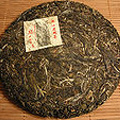
Quotes Tags: Pu-erh, Sheng - Raw Puerh, Shu - Ripe Puerh, Tea production
„Processed green teas, known as "aracha" are stored under low humidity refrigeration in 30 or 60 kg paper bags at 0–5 °C (32–41 °F). This aracha has yet to be refined at this stage, with a final firing taking place before blending, selection, and packaging takes place.“
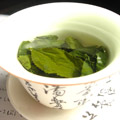
Quotes Tags: Green tea, Tea production
„Green tea is made from the leaves from Camellia sinensis that have undergone minimal oxidation during processing.“

Quotes Tags: Green tea, Tea oxidation, Tea production
Teas
2013 Darjeeling Thurbo Moonlight First Flush
 2 reviews
2 reviewsThe legend among tea cultivators Mr. J. D. Rai, the main teamaker of famous Thurbo gardens produced limited...
Sencha Ohira 2012
 1 review
1 reviewTea is an originally packaged in Japan and stored at low temperatures in Slovakia, which guarantees...
SeJak 2014 ECO Korea
 1 review
1 reviewKorean green tea picked in the spring of 2014 in Hadong district, Jiri mountains. Grown and produced by an...
Theme
Tea by region
We will help you with tea selection.
Do you like quality loose tea?
We will help you to find the right one for you. Be inspired by tea ratings of other tea lovers. Rating stars could help you.


Review your cup of tea.
Review the tea you are drinking and help other tea lovers to find the right cup of tea.



Quotes
„cha pan (zi); 茶盘(子) - Tea tray. The tray with a drainage system - normally a simple pipe- that is used when making tea. Usually made from bamboo, wood or stone.“



 Shops
Shops Share on Facebook
Share on Facebook






